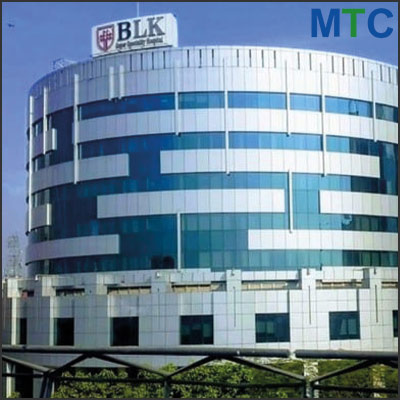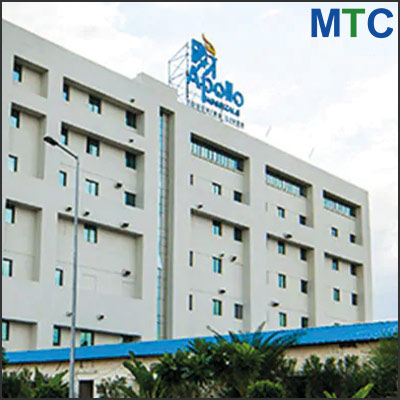Explore best options for Bone Marrow transplant for Leukemia in India.
Choose affordable and accessible treatment to battle leukemia through top-quality oncology care.
Know everything about cost, procedure, donors & success rate in this comprehensive guide.
Cost of Bone Marrow Transplant for Leukemia in India
Cost of bone marrow transplant for leukemia in India is approximately USD 22,000 – 35,000 (INR 18,00,000 -INR 29,00,000). Cost of bone marrow transplant depends on the type of Transplant.
Studies have shown that donor-led Allogeneic transplants are more expensive than patient-led autologous transplants due to external donor fee and longer treatment time.[1]National Library of Medicine
The Cost of Hematopoietic Stem-Cell Transplantation in the United States
“Allogeneic HSCT was more expensive than autologous HSCT, regardless of the regimen used.”
View in Article
Cost Comparison for Bone Marrow Transplant in India and US (in USD)
Here is a clear cost distinction based on the type of bone marrow transplant.
As per latest research studies published in American Society of Haematology, in 2024, the entirety of bone marrow transplant or blood transplant treatment costs over 330,000 USD.
This includes admission, readmission, treatment, ER/OP, pharmacy & medication, conditioning period amongst others.[2]American Society of Hematology
Health care costs among patients with hematologic malignancies receiving allogeneic transplants: a US payer perspective
“’Among those with noncapitated health plans median cost of all-cause health care per patient during the transplant period was $331 827, which was driven by primary hospitalisation and readmission.’”
View in Article
The cost table below also shows the affordable treatment cost in India as compared to the US.
| Transplant Type | India | US |
| Autologous transplant | $22,000 | $140,000[3]NCBI The Cost of Hematopoietic Stem-Cell Transplantation in the United States “The median total healthcare cost at 100 days was $289,283 for the myeloablative allogeneic regimen cohort compared with $253,467 for the nonmyeloablative/reduced-intensity allogeneic regimen cohort, and $140,792 for the myeloablative autologous regimen cohort.” View in Article |
| Allogeneic transplant | $28,000 | $330,000[4]ASH Publications Health care costs among patients with hematologic malignancies receiving allogeneic transplants: a US payer perspective “median cost of all-cause health care per patient during the transplant period was $331 827, which was driven by primary hospitalization and readmission.” View in Article |
| Haplo Allogeneic transplant or half-matched transplant | $35,000 | $360,000[5]Science Direct Cost Analysis for Adult Patients with Acute Myeloid Leukemia and Myelodysplastic Syndrome Undergoing Allogeneic Hematopoietic Cell Transplantation “’The median cost of Haplo was 2.88 times higher than MSD, US$355,963” View in Article |
*Prices are subject to change
Why Is Bone Marrow Transplant For Leukemia Expensive?
Research published in Journal of Blood Medicine, says that patients with leukemia spend 70% of treatment expenses for ‘inpatient hospitalisation’.[6]Journal of Blood Medicine
What Does the Economic Burden of Acute Myeloid Leukemia Treatment Look Like for the Next Decade? An Analysis of Key Findings, Challenges and Recommendations
“’Across all these groups, the main driver of cost was inpatient hospitalization, which accounted for about 70% of costs.’”
View in Article
Other imperative cost drivers for bone marrow transplant for leukemia are:
- Getting a donor: If the patient does not match well with a relative, patient might need to get a donor from global registry, which can be very expensive.
- Preparation: Before transplant, patients require medication and chemotherapy to kill the abnormal WBC Chemotherapy can be an added cost for the patient.
- Transplant procedure: This requires specialised equipment and medical care. If there is a relapse or the cancer progresses, extra consultations and treatment could shoot up cost.
- Aftercare: Patients need medicines to prevent rejection and follow-up visits to make sure the transplant is effective.
Ready to combat cancer? Contact us to know your eligibility for a bone marrow transplant.
How Can International Patients Get Bone Marrow Transplant for Leukemia in India?
With highly affordable prices, haematological experts and advanced technology, India is leading to become one of the most reliable bone marrow transplant destinations for leukemia patients.
Find out how International Patients can get treated for leukemia with bone marrow transplant in India.
First Touch-Point With Medical Tourism Advisors
Our Medical Tourism Advisors connect with International patients and help them find the right fit for a Bone Marrow Transplant Program.
First, patients share initial reports with our advisors. The reports include:
- Initial scans and results
- Existing lab reports
- Medical files
- High-resolution HLA reports
Patients are required to share only HLA results which show the exact HLA count. Low resolution images will not give the doctors accurate results.
If you do not have existing medical reports, there is nothing to worry! Our team will help you.
All you need to do is fill out the form on screen and let us guide you.
Why is HLA important for Bone Marrow Transplant?
Human Leukocyte Antigen is a type of gene in our body. To get a bone marrow transplant, patient’s HLA count needs to match with the donor HLA perfectly.
If stem cells from an unmatched HLA enter the patient’s body, the immune system thinks of it as foreign entity and fights it. If the HLA matches perfectly, the patient body will accept the healthy bone marrow and recover.
Identifying the Right Donor Is the Key!

After we find the patient a right fit with a hospital, the doctors examine initial reports and plan for a bone marrow transplant. Here the type of donor is decided.
| Donor Type | Who It Can Be | Matching Level |
| Allogeneic | Sibling | Complete match |
| Haplo- Allogeneic | Parent, child, relative | Partial match (50%) |
| ‘Matched Unrelated Donor’ | Non-related, from the donor registry | Complete match |
- Usually, a sibling is a perfect HLA match to do an Allogeneic transplant.
- If there are no siblings, doctors recommend Haplo-allogeneic transplant. Haplo donor can be patient’s parent, child or a very close relative. This is mostly a 50% match with higher rejection chance.
- To combat this, patient can try the ‘matched unrelated donor’, using the global donor registry. This process is most expensive but gives patient a greater chance of finding a good match.
Are there other donor options if HLA does not match with relatives?
Doctors can recommend umbilical cord blood if the patient does not get a match from a relative.
Our partner hospitals in India keep a donor registry where umbilical donor blood is stored.
Umbilical cord contains immature stem cells which can be used to get healthy marrow.[7]American Society of Clinical Oncology
How Umbilical Cord Blood Can Save Someone’s Life
“Hematopoietic stem cells are the immature blood-forming cells found in everyone’s blood and bone marrow.”
View in Article
Treating Leukemia With Multidisciplinary Oncology Treatments
Before travel to India, doctors will check the level of chemotherapy patient’s have received in their home countries.
Patients with leukemia require 2 – 3 sessions of chemotherapy to kill the abnormal stem cells.
The patient needs to get the bone marrow transplant for healthy stem cells within 4-5 days after the chemotherapy.
This is the time they need to travel to India.
Travel to India for Bone Marrow Transplant
During the entirety of the patient’s treatment, the doctor plans the exact travel time to India for the patient.
So what is this exact timing?
Before a bone marrow transplant the patient requires 2-3 sessions of chemotherapy to kill the abnormal stem cells.
Once the unhealthy cells die, healthy cells need to be inserted in the patient body through the bone marrow transplant within 4-5 days after the last chemotherapy session.
The doctor keeps this timeline in mind and schedules patient travel to India.
Once the travel timeline is set, our medical advisors ensure all travel related documents are processed seamlessly.
Patients are connected with a specific point of contact who handles the overall journey.
Once in India, the doctor prepares for the treatment.
For an Allogeneic Transplant:
- Recovery time for the patient: 35 days after the transplant surgery is complete
For Autologous Transplant:
- Recovery time for patient: 21 days
Bone Marrow Transplant for Leukemia in India: A Quick Background
Bone marrow is the home of blood cells. bone marrow contains stem cells, which are responsible for making 3 types of blood cells in our body.
So, why are blood cells so important?
Here are the 3 highly important blood cells and their uses.
- Red Blood Cells (Carries oxygen around the body)
- White Blood Cells (Fights infections and diseases)
- Platelets (Forms clots to prevent excess bleeding)
These blood cells ensure our body remains healthy and happy! Bone marrow transplant is also called stem cell transplant.
Leukemia and Its Effect on the Body
Leukemia is cancer of the blood. It starts in the bone marrow and then spreads along the body.
In patients with Leukemia, the bone marrow starts making abnormal white blood cells which survive better than normal cells and affect their capability to fight infections.
This makes the patient’s body weak and diseased. Patients with Leukemia have unhealthy bone marrow and blood.
Type 1
Acute Myeloid Leukemia (AML)
- AML is the most aggressive type of Leukemia.
- The cancer affects Myeloid cells which are a type of white blood cells and makes them abnormal.
- These abnormal cells multiply rapidly and prevent good cells from functioning.
- AML occurs in adults, especially those above 60.[8]National Library of Medicine
Acute myeloid leukemia in the older adults
“AML is an aggressive hematological malignancy with highest incidence in the older adults”
View in Article
Type 2
Acute Lymphocytic Leukemia (ALL)
- ALL affects Lymphocytes, which are also a type of white blood cells that help fight infection.
- The abnormal lymphocytes increase rapidly and disrupt healthy functioning cells.
- This type of cancer mostly affects children but can also affect adults.[9]American Society of Hematology
Blood Cancers
“’The high number of abnormal white blood cells are not able to fight infection, and they impair the ability of the bone marrow to produce red blood cells and platelets.’”
View in Article
Type 3
Chronic Myeloid Leukemia (CML)
CML is a similar type of leukemia as AML. Both types of leukemia affect the myeloid cells.
However, the abnormal myeloid cell production in AML is rapid whereas in CML is slower and manageable.
CML occurs in older adults and rarely happens in children.[10]American Cancer Society
What Is Chronic Myeloid Leukemia?
“’In CML, a genetic change takes place in an early (immature) version of myeloid cells — the cells that make red blood cells, platelets, and most types of white blood cells (except lymphocytes).”
View in Article
Bone Marrow Transplant To Treat Leukemia
Bone Marrow Transplant involves replacing the unhealthy bone marrow of the patient with healthy bone marrow.
The healthy bone marrow can be taken from a donor or the patient itself.
| Donor Type | Description |
| Autologous | Patient’s bone marrow is used. No outside donor. |
| Allogeneic | Donor is external and a perfect match. 1 in 4 times the sibling is a perfect match. This is the most common type of transplant donor.[11]Cancer Research UK Who can donate stem cells or bone marrow? “’A brother or sister is most likely to be a match. There is a 1 in 4 chance of your cells matching. This is called a matched related donor (MRD) transplant. Anyone else in the family is unlikely to match.” View in Article |
| Haplo Allogeneic | Donor is external, and partial or 50 % match. Can be parents, children or sometimes other relatives.[12]National Marrow Donor Program Haploidentical transplant “A haploidentical, or half-matched, donor is usually your mom, your dad or your child.” View in Article |
| Syngeneic | Donor is the identical twin of the patient. |
What Is the Success Rate of Bone Marrow Transplant for Leukemia in India?
The success rate of bone marrow transplant for leukemia in India is approximately 81%.[13]American Society of Transplantation and Cellular Therapy
Hematopoietic Stem Cell Transplant Outcomes in Patients with Acute Myeloid Leukemia from a Tertiary Care Center in South Inida
“’ Disease status at latest follow up showed that 81% were in remission and 19% had relapsed.”
View in Article
As per research conducted in India in 2020 and published in the official journal of American Society of Transplantation and Cellular Therapy, the remission or recovery rate in the research study was around 81% for allogeneic (sibling donor) transplant.
The success rate has significantly improved in India from 2015, where a study showed the success rate of allogeneic transplant to be 57.1%.[14]Journal of Oncology
Hematopoietic Stem-Cell Transplantation in the Developing World: Experience from a Center in Western India
“’Overall survival rate in our autologous and allogeneic patients is 65.7% and 57.1%, respectively. Our results are comparable to many national and international published reports.”
View in Article
Best Hospital for Bone Marrow Transplant for Leukemia in India
BLK Max Super Speciality Hospital
BLK Max Super Speciality Hospital has the largest bone marrow transplant unit in Asia.
Highly skilled specialists at BLK Max are performing around 2400 bone marrow transplants annually and associating themselves with renowned donor registry, globally.
Highlights
- First hospital in Delhi & NCR to have blood irradiator facility specific to leukemia
- Partnered with renowned Global Bone Marrow Donor Registry
- Registry of Umbilical cord blood
- A state-of-the-art blood bank with facilities like Apheresis, Blood Component Separation and Stem Cell Harvesting
- Nucleic Acid Testing System for screening of blood

BLK Max Super Speciality
Apollo Hospital
Highlights
- 1500 successful bone marrow transplants
- Board certified, best-in-class bone marrow surgeons in the country
- Syngeneic bone marrow treatment with identical twin donor
- Top-notch testing before transplant such as MUGA, Echo, EKG, Pulmonary function test etc.
- Stringent infection control norms.

Apollo Hospital
How Safe is Bone Marrow Transplant for Leukemia in India?
Bone Transplant for Leukemia in India is mostly safe and effective.
A study done in India and published in NCBI showed 95% successful results and indicated safety, tolerance and applicability to Autologous Stem Cell Transplant.[15]National Library of Medicine
Safety and Feasibility of Autologous Mesenchymal Stem Cell Transplantation in Chronic Stroke in Indian patients. A four-year follow up
“’ The reports have been optimistic regarding safety as we did not find any cell related side effects’”
View in Article
Another Indian research study published with the Journal of Pediatric Hematology, deemed Haplo-Allogeneic Stem Cell transplant safe and effective with a survival rate of 70.5% children with acute leukemia.[16]Journal of Pediatric Hematology/Oncology
Haploidentical Stem Cell Transplantation With Post-transplant Cyclophosphamide for Pediatric Acute Leukemia is Safe and Effective
“Overall survival is 70.5% and event-free survival is 64.7%. Median follow-up of all patients was 393 days.”
View in Article
FAQs
Can you survive leukemia with a bone marrow transplant?
Yes, there is a chance of survival with bone marrow transplant.
There are obvious risks associated with bone marrow transplant, but overall studies in India have shown a 70.5 % survival rate.
Which hospital is best for bone marrow transplant in India?
BLK- Max Super Specialty hospital is the best hospital in India for bone marrow transplant.
The hospital also has one of the biggest bone marrow transplant centers in Asia.
Conclusion
With advanced technology, expert oncologists, and significantly lower costs compared to many other countries, India emerges as a top destination for bone marrow transplant.
With success rates on the rise and reputable hospitals leading the way, international patients can find hope to recover from leukemia through bone marrow transplant in India.
Contact us to discuss your donor options.
References
- National Library of Medicine: The Cost of Hematopoietic Stem-Cell Transplantation in the United States
- ASH Publication: Health care costs among patients with hematologic malignancies receiving allogeneic transplants: a US payer perspective
- National Library of Medicine: The Cost of Hematopoietic Stem-Cell Transplantation in the United States
- National Library of Medicine: The Cost of Hematopoietic Stem-Cell Transplantation in the United States
- Science Direct: Cost Analysis for Adult Patients with Acute Myeloid Leukemia and Myelodysplastic Syndrome Undergoing Allogeneic Hematopoietic Cell Transplantation
- Journal of Blood Medicine: What Does the Economic Burden of Acute Myeloid Leukemia Treatment Look Like for the Next Decade? An Analysis of Key Findings, Challenges and Recommendations
- American Society of Clinical Oncology: How Umbilical Cord Blood Can Save Someone’s Life
- National Library of Medicine: Acute myeloid leukemia in the older adults
- American Society of Hematology :Blood Cancers
- American Cancer Society What Is Chronic Myeloid Leukemia?
- Cancer Research UK: Who can donate stem cells or bone marrow?
- National Marrow Donor Program: Haploidentical transplant
- American Society of Transplantation and Cellular Therapy: Hematopoietic Stem Cell Transplant Outcomes in Patients with Acute Myeloid Leukemia from a Tertiary Care Center in South India
- Journal of Oncology: Hematopoietic Stem-Cell Transplantation in the Developing World: Experience from a Center in Western India
- National Library of Medicine: Safety and Feasibility of Autologous Mesenchymal Stem Cell Transplantation in Chronic Stroke in Indian patients. A four-year follow up
- Journal of Pediatric Hematology: Haploidentical Stem Cell Transplantation With Post-transplant Cyclophosphamide for Pediatric Acute Leukemia is Safe and Effective








